|

REGINA
REGINA is the capital
of the Province of Saskatchewan, and is situated on the main line of the
Can adian Pacific Railway, three hundred and fifty miles west of
Winnipeg. As capital of the province it is the seat of government. Here
the Legislative Assembly meets, and all the Departmental and Executive
Offices are situated. In Regina also are the headquarters of the Royal
North-West Mounted Police, and the seat of the Supreme Court of the
province.
Regina is the centre of
the most famous wheat growing district of Saskatchewan. The country in
all directions is level prairie, with the exception of a district some
mne or ten miles away in a north-easterly direction where the land is
somewhat rolling and there is a growth of small poplar trees.
In 1908, the total
yield of all grains in crop districts 1, 2, 4 and 5, an area 204 miles
square, of which Regina is practically the centre, was 93,134,482
bushels, and the total acreage under cultivation 5,250,857 acres From
the other five districts which comprise the rest of the province, each
district being of an equal area, the total yield of all grains was
12.859.,932 bushels, and the total acreage under cultivation 721,444
acres.
Regina, itself on the
main line of the Canadian Pacific Railway, is also the terminus of the
same Company’s line from Areola, which is continued through to Brandon,
a line tapping a very rich and well settled country to the south-east.
The Canadian Pacific Railway has also under course of construction a
line running in a northerly direction from Regina to connect with their
Pheasant Hills' line at a point at or near Bulyea. It is expected that
this will be completed early in the present season. This gives easy
access to Last Mountain Lake, a beautiful sheet of water some sixty
miles long, the foot of which is distant only twenty-five miles from the
city; this will undoubtedly become a very popular summer resort for the
citizens of Regina.
Regina is the southern
terminus of the Canadian Pacific Northern Railway Company’s line from
Prince Albert, and is also the terminus of the same Company’s line from
Brandon. When continued through to the Great Lakes, this will give
Regina the benefit of a competitive road through to the head of
navigation.
The Grand Trunk Pacific
Branch Lines’ Company hold a charter for a line running from Regina to
Melville, a divisional point on the main line of their great
transcontinental railroad, about ninety miles north east of Regina. This
line will be continued to Yorkton, and is one of those for the
construction of which the bonds of the Company were guaranteed by .the
Provincial Government at the last session. It is hoped that it will be
completed this year. As soon as this line is completed, work will be
commenced on the same Company’s Line in a south-easterly direction, for
which the charter reads: “In a south-easterly direction from Regina to a
point on the International Boundary at or near North Portal." Charters
for many other lines are held by various Companies. Regina will almost
certainly become the great distributing centre of the middle West.
The citizens of Regina
have always been firm believers in the principle of municipal ownership,
and the city owns and controls the electric light plant and the water
works system. The electric light plant not only gives an excellent
service at a very low rate, (nine cents per thousand kw. hours for
light) but also yields a fair profit, which goes to reduce the rate of
taxation. The water supply is derived from springs at Boggy Creek, a
distance of about eight miles from the city, where a dam and reservoir
have been constructed with a capacity of over 700,000,000 gallons and a
fall of 85 feet from the reservoir to the power house basin. In laying
the pipe line from the reservoir to the city, numerous springs were
struck, and these have supplied the city without the necessity of
drawing upon the reservoir. The water is well adapted for domestic
purposes for use in steam boilers and other industrial purposes.
The city hall built at
a cost of $175,000, is one of the handsomest buildings in the city. It
contains offices for the Civic Officials, a large auditorium capable of
seating a thousand people, a public library and a handsome and well
fumished council chamber.
The city has reserved
large areas for park purposes. The Victoria Park in the centre of the
city, contains about seven acres; Wascana Park, situated on the banks of
the Lake and facing the Parliament Buildings, contains about forty-five
acres and has been tastefully laid out.
The educational
requirements of the city are well served by the five public schools, the
"separate school,’' and the collegiate institute. All these have been
recently erected.
Among the churches may
be specially mentioned, the Metropolitan Methodist Church, the Knox
Church, St. Paul’s (Anglican) and St. Mary’s (Roman Catholic). There are
many handsome business blocks, and perhaps the finest building in the
city, is the new Post Office.
CALGARY
At a point on the main
line of The Canadian Pacific Railway, 642 miles east of Vancouver, on
the Pacific Coast, and 840 miles west of Winnipeg, the City of Calgary
is picturesquely situated in the valley of the Bow River, at the
confluence of the Bow and Elbow. To the west, the snowy peaks of the
Rooky Mountains are clearly visible. To the north, the country is of a
rolling nature, and is well adapted for diversified farming. Southward
to the International Boundary, much grain is grown, although there are
many large stock farms throughout this district. To the east of Calgary,
for a distance of 180 miles, the Canadian Pacific Railway Company have
undertaken the greatest irrigation scheme in the world. It serves a
district extending over 3,000,000 acres.
The situation and
climatic conditions of Calgary are delightful. Attention may be called
to its altitude of 3,389 feet, its large proportion of sunny days, and
to the warm winds from the west and south-west, known as Chinook winds.
The comparative mildness of the winter is in marked contrast to the cold
of the more central regions of Canada. The following table shows the
average temperature and rainfall, for the ten years prior to 1908, as
recorded at the Government Meteorological Station at Calgary .

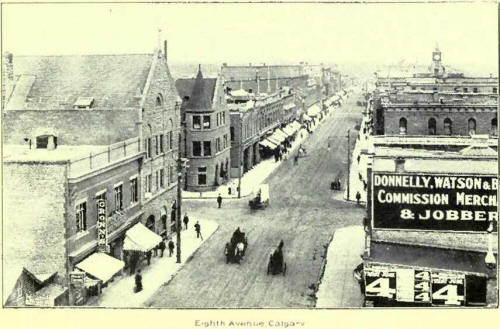
The large business
blocks and public bu.ldings are built of the famous Calgary sandstone,
which is found along the banks of the river. There are about a dozen
quarries within the city limits. The following buildings are under
construction or have been completed within the past twelve months.
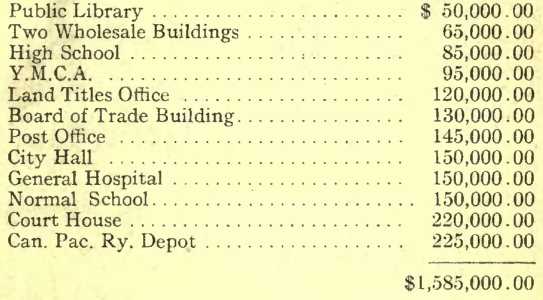
There are more than
nine Public Schools, a High School and a Normal School, a “Separate
School,” a Convent, the Western Canada College for boys, and St. Hilda’s
College for girls. During l‘JU8, there were 3,566 pupils in the Calgary
Schools. These pupils represent eighteen nationalities and speak
fourteen different languages.
The twenty-five
churches in Calgary represent the following denominations: Methodist,
Presbyterian, Baptist, Episcopalian, Roman Catholic, Moravian, Lutheran,
Salvation Army.
The numerous
Commercial, Industrial and Financial Institutions established in
Calgary, place it in the position of the Commercial Metropolis of the
“Last Great West.” The Bank Clearings for the last six months of the
year 1908, were $38,526,454.00, an increase of $3,284,363.00 over the
last six months of 1907. The clearings for the last week of February,
1909, show an increase of 81.5 per cent,. The Customs receipts for 1908,
were $426,425.00.
Three daily papers,
tour weeklies and 'three monthlies, are published in Calgary.
Calgary was founded in
1882, and incorporated as a city two years later. The population in
1901, was 6,557; to-day it is more.than 25,000 The city water supply is
of the best, and is brought from the Rockies via the Bow River.Steam
coal may be obtained in Calgary, at $2.75 per ton upwards, natural gas
has been discovered and negotiations are in progress for the development
of water power on the Bow River. Calgary’s railway facilities are
excellent and a rapid growth and a prosperous future for the eity are
well assured.
BANFF
Banfl is situated at an
altitude of 4,521 feet, and is the station for the Canadian National
Park and Hot Springs This park is a National Reservation of 5,732 square
miles, embracing parts of the valleys of the Bow, Spray and Cascade
Rivers, Lake Minnewanka and several noble mountain ranges, and beyond
the ‘ ‘ Divide, ’ the Yoho valley and the country to the west and south
of it The park is the largest in the world, being nearly half as large
again as the famous Yellowstone Park in the United States. No part of
the Rockies exhibits a greater variety of sublime and pleasing scenery,
and nowhere are good points of view and features of special interest so
accessible, since many good roads and bridle paths have
The notes on Banff are
taken, by permission, from the Annotated Time Table of the Canadian
Pacific Railway Company.
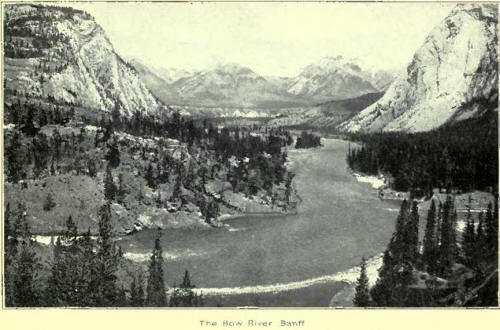
been made. _ The
railway station at Banff is in the midst of impressive mountains. The
huge mass northward is Cascade Mountain (9,825 ft.); eastward is Mount
Inglismaldie, and the heights of the Fairiiolme subrange, behind which
lies Lake Minnewankci. Southeastward from Inglismaldie, in the same
range of the Fairholmes, the sharp cone of Peechee (called after an
Indian chief), closes the view in that direction; this is one of the
highest mountains visible. To the left of Cascade Mountain, and just
north of the track, rises the wooded ridge of Stoney Squaw Mountain,
beneath which lie the Vermilion lakes, seen just after leaving the
station. Up the Bow, westward, tower the distant, snowy, central heights
of the Main range about Simpson’s Pass, most prominently the square,
wall-like crest of Mount Bourgeau. A little nearer, at the left, is seen
the northern end of the Bourgeau range, and still nearer, the razor-like
back of Sulphur Mountain, along the side of which are the Hot Springs,
and on whose summit, at .8,030 ft., an observatory has been established.
The isolated bluff southward is Tunnel Mountain, while just behind the
station, Rundle Peak, 9,665 ft., rises sharply so near at hand as to cut
off all the view in that direction. Just before reaching the station,
the train passes along a large corral of 800 acres in which are a number
of buffalo, the last specimens of the monarchs of the plains. Plans are
now arranged by means of which a collection of bears will be placed in a
corral in some central location in the park. The village of Banff is a
short distance, soulhwest of the station, on the'hither side of the Bow,
and the Canadian Pacific Railway Banff Hotel is about a mile further on.
A steel bridge takes the carriage road across to the magnificent hotel,
built by the Railway Company, on an eminence between the foaming falls
in the Bow and the. mouth of the rapid Spray River. This hotel, which
has every modem convenience and luxury, including baths supplied from
the hot sulphur springs, is kept open from May to October, and thither
people from all lands flock in numbers. It is most favorably placed for
health, picturesque views, and as a centre for canoeing, driving,
walking or mountain-climbing. There are also a sanitarium and hospital
in-the village, and a museum of more than local interst has been
established by the Government. Eight miles from Banff, is Lake
Minnewanka, on which a fine launch has been placed. There is capital
fishing, the trout being of extraordinary size. Wild sheep (the
big-horn) and mountain goats are occasionally to be seen on the
neighboring heights. Some extraordinary fossil remains and markings of
mammoth pre-historic creatures are found on the mountain slopes
surrounding this lake, as well as on Cascade Mountain. At the upper end
of the lake is the valley of Ghost River, a strange region where the
mountain rivulets gurgle off into subterranean reservoirs and the
granite walls are pitted with caves. Between Banff and the lake is
Bankhead, where are located the anthracite mines, operated by the
Canadian Pacific Railway, whose output will shortly provide the country
as far east as Winnipeg with fuel. The hot springs are at different
elevations upon the eastern slope of Sulphur Mountain, the highest being
900 ft. above the Bow. All are reached by tine roads, commanding
glorious landscapes. The more important springs have been improved by
the Government, and picturesque bathing houses have been erected and
placed under the care of attendants. In one locality is a pool inside a
dome-roofed cave, entered by an artificial tunnel; and adjacent, another
spring forms an open basin of warm sulphurous water. Since the opening
of the railway, these springs have been largely visited, and testimony
to their wonderful curative properties i* plentiful. Twenty miles south
of Banff is Mount Assiniboine, the
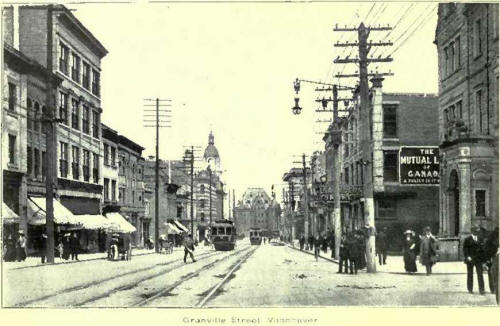
Matterhorn of the new
world, the ascent of which, after several unsuccessful attempts, was
made in the autumr of 1901, by the Rev. James Outram and a party of
Swiss guides. The way to it leads through beautiful valleys studded with
transparent blue lakes and parklike prairie openings.
VANCOUVER, BRITISH
COLUMBIA
Vancouver, the chief
commercial capital Of the western half of the Canadian-American
continent, is situated on the extreme western shore of the mainland of
British Columbia, a distance of fifty miles north of the International
boundary, overlooking the Gulf of Georgia, which, with Vancouver Island
and the Straits of Juan de Fuea, lies between the city and the open
Pacific Ocean. Vancouver was founded in 1886, and has a population of
85,000. Its commercial supremacy is based on the fact that it is the
natural gateway for Canadian and British-Oriental trade and that it is
the converging point of several transcontinental railway lmes, as well
as the port of trans-Pacific shipping. Chief among the transcontinental
lines having their terminals at this point, is the Canadian Pacific
Railway, with through and direct connections from Liverpool and all
European ports via Montreal and St. John, and navigating its own
steamships to Japan and China. The journey from Montreal to Vancouver
occupies 96 hours. There is a regular steamship service to the Orient
from Vancouver. The time from Vancouver to Yokohama is fourteen days; to
Hong Kong 22 days, wirh intervening calls at Kobe, Nagasaki and
Shanghai.
Next in importance is
the trade with the Antipodes, carried on by the Canadian-Australian
line, with a trio of ships called the Aorangi, the Moana and Makura. The
sailings on this line are monthly, the time between Vancouver and
Sydney, (N.S.W.), being approximately thirty days, with calls at
Honolulu, Suva and Brisbane. Both the Canadian-Pacific and the
Canadian-Australian are Royal Mail S. S. lines and close connections are
made with the fast through mails from Liverpool
A “Four-Weekly-Service”
between California points, Mexico, Guatemala, Salvador Honduras and
Nicaragua is also maintained. The trade between these and Canadian ports
is rapidly increasing in importance. Among other “freighters” calling
regularly at the port of Vancouver, are those of the Ocean S.S. Co., and
the China Mutual Steam Navigation Co., operating a monthly service to
Liverpool via Japan, China and the Suez Canal.
The local service
between Vancouver, Victoria and Seattle is triangular and three
magnificent steamers are engaged in the trade Morning and afternoon
sailings are made for Victoria; the distance is 7o miles, and the time
occupied, four hours. From Seattle to Vancouver 1/50 miles, the time
taken is nine hours.
Daily communication is
also maintained with Nanaimo, the centre of Vancouver Island coal mining
industries. This port is forty miles distant and the journey occupies
three hours. The “Coastwise” service is supplied by a flotilla of
steamers operated by numerous steamship companies having their head
offices m Vancouver. By means of these the whole coast line as far north
as Alaska, Queen Charlotte Island and northern British Columbia coast
ports is covered. Sailings are regularly scheduled and average four a
week All the Coastwise steamships of the Puget Sound service also call
at Vancouver on their way to and from the North.
In addition to the
freight and passenger delivery from the Canadian Pacific Railway, the
Great Northern Railway operates three trains daily each way between
Vancouver and Seattle, while extensive plans for additional terminal
facilities have been filed by tnis Company, . and the work of grading
and dock building is already under way. Other American transcontinental
lines have also charters for rights-of-way to this terminal, and
construction is being planned, while several new lines from the interior
of British Columbia, having chartered rights to reach the coast, are
hastening construction, so as to bring the whole of the vast interior of
the province within a few hours travel from Vancouver. Charters were
obtained at the last session of the legislature for lines to extend to
the north in various directions and undertakings have been given that
the work of construction will begin at once.

A single glance at the
geographical position of Vancouver will show how suitable was its
selection as a terminus for these numerous railways and steamship lines.
Burrard Inlet, the landlocked harbour, entered through a narrow channel,
wide, deep and sheltered, affords one of the best anchorages in the
world, while its fourteen odd miles of water front affords facilities
that for wharf and dockage are unsurpassed among the ports of the world.
False Creek, a second waterway at the south of the business section of
the city, needing only inconsiderable artificial development, affords
another channel for docking big ships, and a shore line furnishing many
miles of factory and mill front.
The business portion of
the city occupies the centre of a gently elevated peninsula, which
slopes northward southward and westward to salt water. The oldest and
most fashionable residential section is in the West End, occupying the
terraces between the business portion and Stanley Park, with its shore
line &t English Bay. Otherwise, the suburban residential sections are in
the east and across False Creek, from which they slope southward and
eastward like the terraces of a vast natural amphitheatre.
In the business section
of the city the wide, well paved and well-kept streets and the
substantial character and architectural qualities of many of the
business houses furnish impressive evidences of material prosperity, and
of the confidence of investors in the future greatness of the city. The
city is well provided with tram lines. There is also a double track
inter-urban service with the city of New Westminster, twelve miles
distant, which is being continued through the rich lands of the Fraser
Valley to the city of Chilliwack. A further rural extension of the tram
line connects with Steveston, the capital of the salmon fishing
industry, at the mouth of the Fraser River.
The scenery of Stanley
and English Bay forms one of the chief charms of Vancouver. Stanley Park
consists of 1,000 acres of natural scenery., Situated upon a peninsula
which is almost an island, the park is nine miles in circumference and
within its grounds are some of the most magnificent specimens of the big
trees of British Columbia. English Bay, the long stretch of water
fronting on the Gulf of Georgia, affords bathing facilities unrivalled
on the Pacific coast. The Gulf, gemmed with emerald islands studding its
placid surface, stretches towards the north and south as far as the eye
can reach, while across its hazy distance is the Olympic range of
mountains with their snow-capped peaks, and on the north the Cascade
range nearer at hand, with the serrated heights severely outlined
against the sky.
VICTORIA, VANCOUVER
ISLAND, BRITISH COLUMBIA
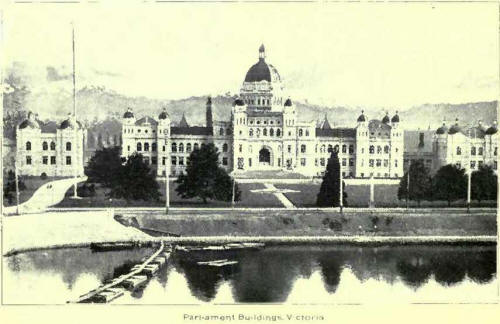
Victoria being the
first port entered by all steamships from Australia, Japan, China and
other Oriental countries, having large and varied commercial
enterprises, and being the capital of the largest and richest of the
Canadian provinces, is of more than ordinary interest to strangers, and
is none the less so because it happens to be one of the most charmingly
situated cities in the world. It is the Pacific terminus of the Canadian
Pacific Railway system in Canada, has a population of nearly 40,000 and
occupies an ideal situation at the extreme southern end of Vancouver
Island, within a few hours’ sail of the mainland of British Columbia and
of the United States.
It is agreed that the
picturesque situation of Victoria is unsurpassed. From Beacon Hill Park
can be seen on one hand the rugged snow-clad Olympians, and on the
other, rising proudly in the distance beyond the island studded straits
of Juan de Fuca, the lordly Mount Baker. The combination of magnificent
scenery and almost perfect climate is destined to render Victoria one of
the largest and richest residential cities on the continent. Victoria,
has excellent hotel accommodation. The Canadian Pacific Railway have, in
the heart of the city, overlooking the picturesque harbour, one of the
finest hotels on the continent, “The Empress.”
The public schools of
Victoria, which are free to everyone under 21 years of age, are
up-to-date in every respect. The High School is in affiliation with the
University of McGill, Montreal. Besides its public educational system,
the city is the home of a large number of private colleges and academies
both for boys and girls. The Parliament Building is acknowledged to be
one of the handsomest and most imposing structures on the continent. It
is one of the first sights to catch the visitor’s eye as he enters the
harbour of Victoria. It stands amid spacious and beautifully kept lawns,
the vivid green of which testifies to the mildness of the climate.
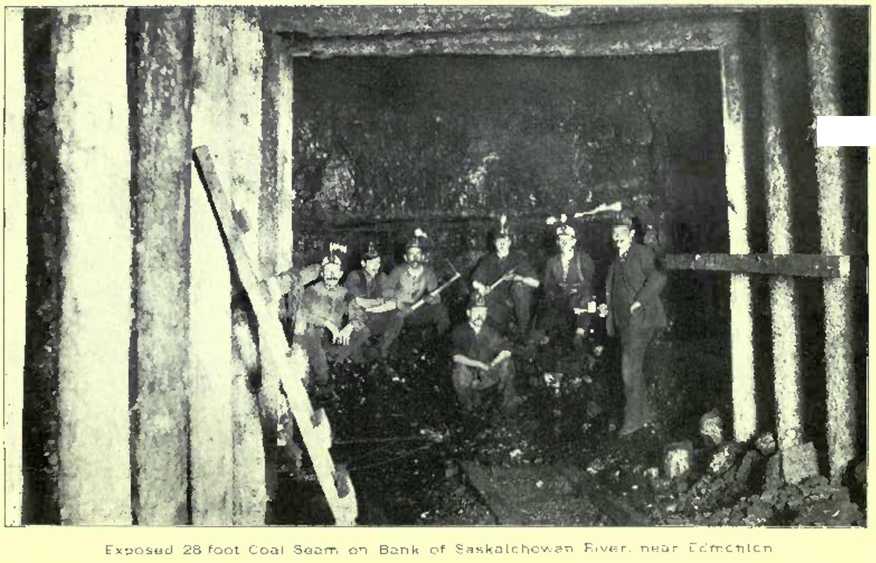
Built as it is or the
steep banks of the North Saskatchewan and amid the bush which grows out
from the river, it enjoys the best and most picturesque situation of any
of the prairie cities. The river is both narrow and rapid at that point,
and as a result, has bored a deep channel in the plains, leaving high
banks covered with trees which give the city, from certain points, the
appearance of standing on a hill and differentiates its aspect from
other cities which are surrounded on every side by the level prairie. It
has been laid out with care and taste. The streets are wide and well
arranged, and every convenience such as electric light, street car
service, telephones and water supplies have been secured for the
inhabitants. The principal thoroughfare is Jasper Avenue running
parallel to the river: the other chief streets branch off from it and it
contains most of the banks and important business establishments. The
city has twenty two hotels, fourteen banks, ten schools and twenty
churches, and the visitor will be surprised at the size and excellent
appearance of many of the buildings. Edmonton is the headquarters of the
Provincial Government of Alberta, and the. Local Legislature’s presence
makes it the centre of provincial Society and public business. The Land
Titles Office for the whole of the vast territory of Northern Alberta,
is in the city and a large new Court House has just been erected.
Edmonton has always
been a great fur-trading centre and to day the Hudson’s Bay Company and
their great rivals, Revilion Brothers, secure a large proportion of
their purchases of fur through their establishment here.
But it has ceased to be
dependent on this trade alone, and is now the second largest
distributing centre between the Lakes and the Rockies. It is the place
from which the country storekeepers of North Alberta and the settlers,
traders and construction gangs engaged in the development of an enormous
area of territory derive their supplies : as a result, every wholesale
house of any importance has a branch or agency and its volume of annual
trade is developing in an unprecedented manner. It is also a very
important railway centre; the Canadian Northern have had their western
terminus there for four years and the Grand Trunk Pacific have just
completed their tracks into the city. At present, the Canadian Pacific
passenger trains only run to Strathcona on the north side of the river,
but this Company intends, in the immediate future, to cooperate with the
two cities in constructing a much needed high level bridge for railway
and other traffic. At present Edmonton has 25,000 inhabitants and
Strathcona about 7,000: a friendly but keen rivalry exists between the
two places, but sooner or later they are destined to be harmoniously
united. Edmonton, as the capital, has the better prospects but the
smaller city has recently received a handsome solatium in the shape of
the Provincial University.
Edmonton is
particularly fortunate an one respect: it is built on extensive coal
beds of fairly good quality and at least half a score of coal mines are
in operation in the immediate vicinity of the city. This is ir itself an
enormous advantage as it must decrease the cost of living in winter and
offer great attractions to the establishment of manufactures. Again,
within 20 miles of the city, are extensive marl beds, brick or pottery
clay-deposits, asphalt, and, further away, deposits of iron ' successful
dredging operations for gold are. also carried on in the river within
the city precincts.
Not so long ago
Edmonton was regarded as the frontier post of civilisation and
settlement in the Northwest, but to-day the Canadian Northern and Grand
Trank. Pacific are rapidly pushing their transcontinental lines
westward, projecting new branches and planning to open up vast tracts of
fertile country. Homesteaders are flocking in, villages are springing up
and the wilderness is being tamed by science and labor. At Edmonton the
visitor will hear little else talked of but a certain land of promise
called the Peace River Valley, to which the eyes of the world are, some
day, to be turned as a greater wheat-growing area than the Saskatchewan
Valley. The people of Edmonton regard Manitoba ['and Ontario as old
decadent civilisations and talk glibly of the greater prospects of the
vast country to the north of their city. Their enthusiastic hopes have
certain strong foundations in fact and are bound at least to be
partially realized. But the future of Edmonton itself is assured though
the Peace River Valley should prove to be a very barren tract which is
unthinkable and the Alberta capital may yet become a serious rival of
Winnipeg for the position of premier city in Western Canada. Happily
there is room for two great cities in this vast land and each has a
territory larger than most European countries to dominate as a
political, social and commercial centre. |
